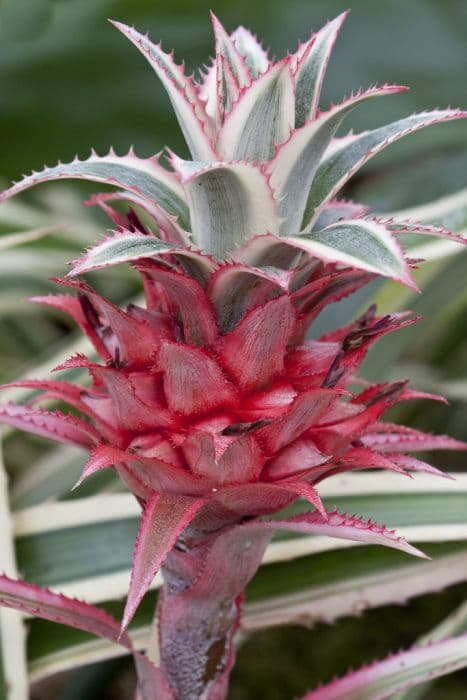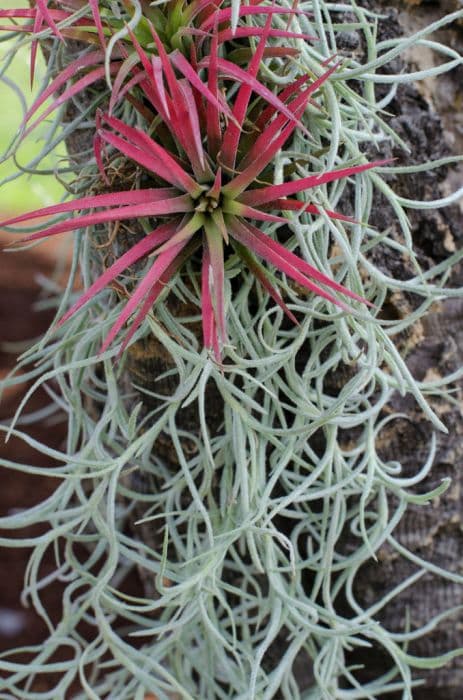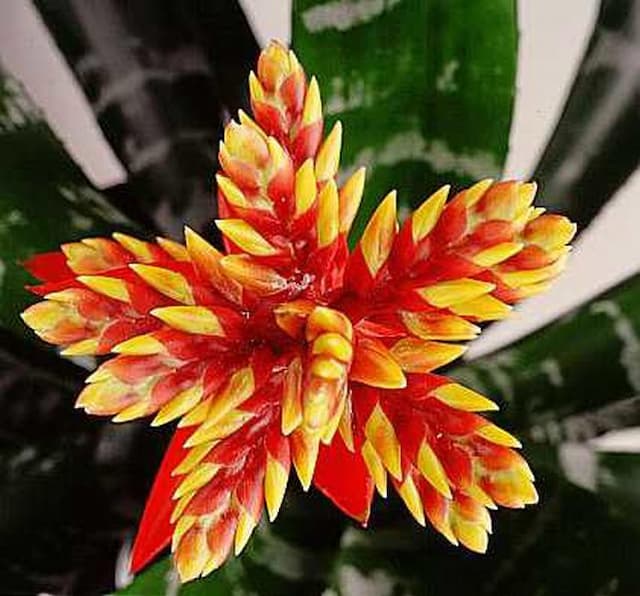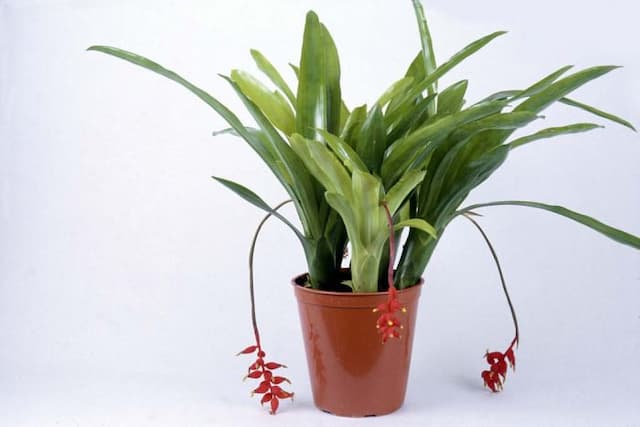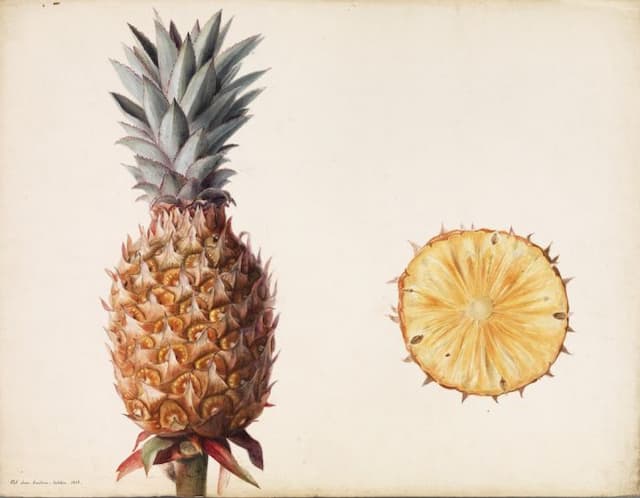Earth Star Cryptanthus bivittatus 'Pink Starlite' (v)

ABOUT
The plant known as 'Pink Starlite' is a charming and colorful variety with a vibrant and eye-catching appearance. Its foliage is a striking blend of pink and green, with each leaf exhibiting bands or stripes that contrast beautifully against the main color. The leaves themselves are narrow and elongated, coming to a sharp point at the end, which grants the overall silhouette of the plant a star-like shape. These leaves radiate out from the center, creating a rosette pattern that is both symmetrical and attractive. Intensity of the pink hue can vary, potentially becoming more pronounced when the plant receives more light, adding to its dynamic visual appeal. Texturally, the leaves may have a slight roughness, often with a feeling akin to fine sandpaper due to minuscule scales on the surface. The 'Pink Starlite' has a tight, compact form, contributing to its popularity as an ornamental houseplant that captures the attention of onlookers with its stunning leaf coloration and arrangement.
About this plant
 Names
NamesFamily
Bromeliaceae
Synonyms
Earth Star, Starfish Plant, Pink Starlite
Common names
Cryptanthus bivittatus 'Pink Starlite'
 Toxicity
ToxicityTo humans
Earth Star is generally considered non-toxic to humans. There is no well-documented toxicity associated with ingesting any part of the Earth Star plant. Therefore, no specific symptoms of poisoning are expected. However, it's always wise to avoid ingesting plants that are not intended for consumption, as individual sensitivity may vary.
To pets
Earth Star is not known to be toxic to pets. It is not listed among the common poisonous plants to cats, dogs, or other pets, and ingestion of parts of an Earth Star plant typically should not cause any significant symptoms of poisoning. As with any non-food item, ingestion of plant material could potentially cause mild stomach upset depending on your pet's sensitivity or if consumed in large quantities.
 Characteristics
CharacteristicsLife cycle
Perennials
Foliage type
Evergreen
Color of leaves
Variegated
Height
6 inches (15 cm)
Spread
6 inches (15 cm)
Plant type
Bromeliad
Hardiness zones
11
Native area
Brazil
Benefits
 General Benefits
General Benefits- Low Maintenance: Easy to care for, requiring minimal attention once established.
- Drought Tolerant: Can survive without regular watering, making it suitable for xeriscaping and busy gardeners.
- Unique Foliage: Offers attractive, variegated pink and green leaves that provide a splash of color indoors or in the garden.
- Compact Size: Its small size makes it an ideal choice for terrariums, small containers, and spaces with limited room.
- Fast Growing: Grows quickly under suitable conditions, providing rapid gratification for gardeners and indoor plant enthusiasts.
- Easy Propagation: Can be easily propagated from offshoots or leaves, allowing gardeners to expand their collection or share with others.
- Pet Friendly: Non-toxic to pets, which makes it a safe choice for households with animals.
 Medical Properties
Medical PropertiesThis plant is not used for medical purposes.
 Air-purifying Qualities
Air-purifying QualitiesThis plant is not specifically known for air purifying qualities.
 Other Uses
Other Uses- Cryptanthus bivittatus 'Pink Starlite' can serve as a living mulch in garden beds, helping to retain soil moisture and suppress weeds.
- This plant can be used in a terrarium setup, adding a touch of color and texture to miniature landscapes.
- Because of its striking appearance, Cryptanthus bivittatus 'Pink Starlite' can be used as a natural art element in ikebana or other floral arrangements.
- The plant may also be employed as a teaching tool in botany or horticulture classes to illustrate epiphytic plant adaptations.
- They are suitable for paludariums – enclosed environments that incorporate both terrestrial and aquatic elements – due to their adaptability to various conditions.
- This variety of Cryptanthus can be used in biophilic design to enhance the connection between indoor spaces and nature through its vibrant color and pattern.
- It can be a colorful addition to fairy gardens, providing an imaginative backdrop for miniature figurines and accessories.
- The spiky texture and rosette form of Cryptanthus bivittatus 'Pink Starlite' is perfect for sensory gardens, stimulating touch and sight.
- In pet-safe areas, it can provide non-toxic interest in spaces where domestic animals like cats may enjoy nibbling on safe greens.
- Their ability to grow in low light conditions makes them a good choice for adding vibrancy to darker corners of interior design projects.
Interesting Facts
 Feng Shui
Feng ShuiEarth Star is not used in Feng Shui practice.
 Zodiac Sign Compitability
Zodiac Sign CompitabilityEarth Star is not used in astrology practice.
 Plant Symbolism
Plant Symbolism- Resilience: Cryptanthus bivittatus 'Pink Starlite,' commonly known as Earth Star, symbolizes resilience because it can thrive under a variety of indoor conditions and adapt to less than ideal environments.
- Uniqueness: Its distinctive star-like rosette and vivid pink coloring represent individuality and the beauty of being unique.
- Balance and Harmony: The symmetrical nature of the Earth Star's foliage may be interpreted as a representation of balance and harmony in life.
- Lust for Life: The Earth Star's bright colors and bold presentation symbolize a zest for life and an enthusiasm for the world around us.
- Protection: In some cultures, spiky plants like the Earth Star are considered to protect against negative energy and symbolize a safe haven.
 Water
WaterFor Earth Stars, you should allow the soil to dry out slightly between watering. Typically, watering every 7 to 10 days should suffice. When you do water, aim to keep the soil evenly moist but not soggy by providing about 8-12 ounces of water for a medium-sized pot. Avoid allowing the plant to sit in standing water which can lead to root rot. During the winter months, reduce the frequency to prevent overwatering when the plant's growth slows down.
 Light
LightEarth Stars prefer bright, indirect light to maintain their vibrant leaf colors without getting sunburned. A north or east-facing window is ideal as it provides consistent, diffused light. They can tolerate some shade, but too little light can cause the leaves to fade and the plant may become leggy as it reaches for more light.
 Temperature
TemperatureEarth Stars thrive best in temperatures between 60 to 80 degrees Fahrenheit. They can survive a minimum temperature of 50 degrees Fahrenheit but should be protected from sudden temperature drops. Avoid placing them in areas with cold drafts or directly under air conditioning units that could cause temperature fluctuations outside their comfortable range.
 Pruning
PruningPruning is not typically necessary for Earth Stars, but you may remove dead or damaged leaves as needed to encourage new growth and maintain its appearance. The best time to prune is in the growing season when the plant can easily recover. Use clean, sharp scissors to cut the foliage at the base without harming the healthy parts.
 Cleaning
CleaningAs needed
 Soil
SoilEarth Star needs well-draining soil with good aeration, typically a mix of peat, perlite, and pine bark in equal parts. Aim for a slightly acidic to neutral pH ranging from 5.5 to 7.0 for optimal growth.
 Repotting
RepottingEarth Stars should be repotted every 2-3 years to prevent them from becoming root-bound and to refresh the soil, ensuring nutrients are available for healthy growth.
 Humidity & Misting
Humidity & MistingEarth Star thrives at a humidity level of 50-70%, so it's important to maintain this range for the plant to flourish, especially if the air in your home is dry.
 Suitable locations
Suitable locationsIndoor
Provide bright, indirect light and warmth for Earth Star growth.
Outdoor
Grow Earth Star in shaded areas with protection from direct sun.
Hardiness zone
9-11 USDA
 Life cycle
Life cycleCryptanthus bivittatus 'Pink Starlite', commonly known as Earth Star, begins its life cycle with the germination of seeds in a warm, moist environment, where light is not necessary for germination. After sprouting, the seedling matures into a rosette-shaped plant with pink-striped leaves, a phase that can last for several years given appropriate light, temperature, and moisture conditions. Throughout its life, the Earth Star will produce offsets, or "pups," which grow from the base of the parent plant and can be separated to propagate new plants. The plant reaches maturity when it blooms with small, inconspicuous white flowers that are not the focal point, as the plant is primarily grown for its colorful foliage. After flowering, which can take years to occur, the plant's main rosette slowly begins to decline. However, the life cycle continues through the pups, which take over as the next generation, while the parent plant eventually dies back.
 Propogation
PropogationPropogation time
Spring to Summer
Propogation: The Earth Star, better known as Cryptanthus bivittatus 'Pink Starlite', is typically propagated by offsets. The best time to propagate Earth Stars is during the spring or early summer, when the plant is actively growing. To propagate using offsets, also known as "pups," one must wait until the pup is about one-third the size of the parent plant and has several of its own roots. Gently separate the pup from the mother plant by either pulling it apart with a twisting motion or cutting it with a sterilized knife, if necessary. Then, plant the pup in its own pot, using a well-draining soil mix designed for bromeliads or epiphytes, and keep the soil lightly moist until the pup is well established. It’s important to provide bright, indirect light and avoid deep watering to prevent rot at this stage.

